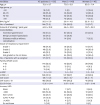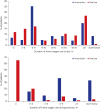1. Kent BD, Mitchell PD, McNicholas WT. Hypoxemia in patients with COPD: cause, effects, and disease progression. Int J Chron Obstruct Pulmon Dis. 2011; 6:199–208.


2. Medical Research Council Working Party. Long term domiciliary oxygen therapy in chronic hypoxic cor pulmonale complicating chronic bronchitis and emphysema. Report of the Medical Research Council Working Party. Lancet. 1981; (8222):681–686.
3. Nocturnal Oxygen Therapy Trial Group. Continuous or nocturnal oxygen therapy in hypoxemic chronic obstructive lung disease: a clinical trial. Ann Intern Med. 1980; 93(3):391–398.

4. Morrison DA, Stovall JR. Increased exercise capacity in hypoxemic patients after long-term oxygen therapy. Chest. 1992; 102(2):542–550.


5. Wedzicha JA. Effects of long-term oxygen therapy on neuropsychiatric function and quality of life. Respir Care. 2000; 45(1):119–124.

6. Eaton T, Lewis C, Young P, Kennedy Y, Garrett JE, Kolbe J. Long-term oxygen therapy improves health-related quality of life. Respir Med. 2004; 98(4):285–293.


7. Zieliński J, Tobiasz M, Hawryłkiewicz I, Sliwiński P, Pałasiewicz G. Effects of long-term oxygen therapy on pulmonary hemodynamics in COPD patients: a 6-year prospective study. Chest. 1998; 113(1):65–70.

8. Hardinge M, Annandale J, Bourne S, Cooper B, Evans A, Freeman D, et al. British Thoracic Society guidelines for home oxygen use in adults. Thorax. 2015; 70:Suppl 1. i1–i43.
10. Ringbaek TJ, Lange P. The impact of the Danish Oxygen Register on adherence to guidelines for long-term oxygen therapy in COPD patients. Respir Med. 2006; 100(2):218–225.

11. Clini E, Veale D, Winck JC, Muir JF, Kampelmacher M, Vivodtzev I, et al. Advances in ambulatory oxygen workshop and long-term oxygen therapy in real-life practice. Eur Med J. 2015; 3(2):63–70.
12. Doherty DE, Petty TL, Bailey W, Carlin B, Cassaburi R, Christopher K, et al. Recommendations of the 6th long-term oxygen therapy consensus conference. Respir Care. 2006; 51(5):519–525.

13. Jacobs SS, Lederer DJ, Garvey CM, Hernandez C, Lindell KO, McLaughlin S, et al. Optimizing home oxygen therapy. An official American Thoracic Society workshop report. Ann Am Thorac Soc. 2018; 15(12):1369–1381.


14. Global Initiative for Chronic Obstructive Lung Disease. Global strategy for prevention, diagnosis and management of COPD (2019 Report). Accessed April 8, 2019.
http://www.goldcopd.org.
16. Jo MW, Yun SC, Lee SI. Estimating quality weights for EQ-5D health states with the time trade-off method in South Korea. Value Health. 2008; 11(7):1186–1189.


17. Smilkstein G. The family APGAR: a proposal for a family function test and its use by physicians. J Fam Pract. 1978; 6(6):1231–1239.

19. Jeong YH. A report on the health related quality of life in Korea. Health Welf Policy Forum. 2011. 182:p. 6–14.
20. Ståhl E, Lindberg A, Jansson SA, Rönmark E, Svensson K, Andersson F, et al. Health-related quality of life is related to COPD disease severity. Health Qual Life Outcomes. 2005; 3(1):56.


23. Rutten-van Mölken MP, Oostenbrink JB, Tashkin DP, Burkhart D, Monz BU. Does quality of life of COPD patients as measured by the generic EuroQol five-dimension questionnaire differentiate between COPD severity stages? Chest. 2006; 130(4):1117–1128.


24. Punekar YS, Rodriguez-Roisin R, Sculpher M, Jones P, Spencer M. Implications of chronic obstructive pulmonary disease (COPD) on patients’ health status: a western view. Respir Med. 2007; 101(3):661–669.


25. Kim JH, Kim EK, Park SH, Lee KA, Hwang YI, Kim EJ, et al. Burden of COPD among family caregivers. Tuberc Respir Dis (Seoul). 2010; 69(6):434–441.

26. Pépin JL, Barjhoux CE, Deschaux C, Brambilla C. Long-term oxygen therapy at home. Compliance with medical prescription and effective use of therapy. ANTADIR Working Group on Oxygen Therapy. Association Nationale de Traitement à Domicile des Insuffisants Respiratories. Chest. 1996; 109(5):1144–1150.

27. Esteban C, Quintana JM, Aburto M, Moraza J, Egurrola M, Pérez-Izquierdo J, et al. Impact of changes in physical activity on health-related quality of life among patients with COPD. Eur Respir J. 2010; 36(2):292–300.


28. Park MJ, Yoo JH, Choi CW, Kim YK, Yoon HK, Kang KH, et al. Long-term oxygen therapy for chronic respiratory insufficiency: the situation in Korea after the health insurance coverage: a multi-center Korean survey. Tuberc Respir Dis (Seoul). 2009; 67(2):88–94.
29. Ringbaek TJ, Lange P, Viskum K. Are patients on long-term oxygen therapy followed up properly? Data from the Danish Oxygen Register. J Intern Med. 2001; 250(2):131–136.

30. Ringbaek TJ, Lange P. Trends in long-term oxygen therapy for COPD in Denmark from 2001 to 2010. Respir Med. 2014; 108(3):511–516.


32. Ringbaek TJ, Lange P, Viskum K. Geographic variation in long-term oxygen therapy in Denmark: factors related to adherence to guidelines for long-term oxygen therapy. Chest. 2001; 119(6):1711–1716.

33. Guarascio AJ, Ray SM, Finch CK, Self TH. The clinical and economic burden of chronic obstructive pulmonary disease in the USA. Clinicoecon Outcomes Res. 2013; 5:235–245.


34. Ringbaek TJ, Viskum K, Lange P. Does long-term oxygen therapy reduce hospitalisation in hypoxaemic chronic obstructive pulmonary disease? Eur Respir J. 2002; 20(1):38–42.


35. Farrero E, Escarrabill J, Prats E, Maderal M, Manresa F. Impact of a hospital-based home-care program on the management of COPD patients receiving long-term oxygen therapy. Chest. 2001; 119(2):364–369.


37. Gauthier A, Bernard S, Bernard E, Simard S, Maltais F, Lacasse Y. Adherence to long-term oxygen therapy in patients with chronic obstructive pulmonary disease. Chron Respir Dis. 2019; 16:1–9.









 PDF
PDF Citation
Citation Print
Print




 XML Download
XML Download